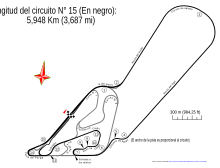Argentine Grand Prix
After a six-year break and by then Juan Peron in office, racing resumed in 1947 at Retiro with the start of the South American "Temporada" Grand Prix series, competing twice that year under the Formula Libre regulations.
Built in 1952 on swampland just outside Buenos Aires, the circuit featured a white archway dedicated to the memory of Admiral William Brown.
The circuit opened in March 1952 with the fifth edition of the "Perón Cup", which was won by Juan Manuel Fangio[1] and in 1953, hosted the first Formula One race to be held in South America.
[3][4][5] In 1972 the Argentine Grand Prix returned to the World Championship, with Carlos Reutemann emerging as the new home favorite.
1977 saw South African Jody Scheckter take an amazing victory in the Walter Wolf team's first ever Grand Prix in extremely hot weather, and 1978 saw Mario Andretti begin his domination of that season, driving for Lotus.
The race went ahead anyway after some repairs (which proved not to be good enough, and the track broke up again) and Australian Alan Jones in a Williams, Brazilian Nelson Piquet in a Brabham, Canadian Gilles Villeneuve, Laffite and Reutemann all battled for top positions; Reutemann went out early with engine problems after he went off the circuit after attempting to pass Piquet and he got grass in his radiators.
[6] The 1981 race, which was held in cooler April weather, was a Brabham procession; designer Gordon Murray found a way to circumvent the new regulations with a hydropneumatic suspension which lowered the cars closer to the ground; and therefore were faster around corners than everyone else.
The 1982 round was supposed to be held in early March, but the political fallout during the drivers strike just before the South African Grand Prix caused the sponsors of the Argentine Grand Prix to back out of the race;[7] and the race was initially postponed five weeks before it was due to take place; and then the Argentine political situation was problematic and they also entered a brief war with the United Kingdom over the Falkland Islands in early April, and within the context of an entirely European sport that consisted mostly of British organizations, this caused the Argentine organizers' contract to be terminated.
[8][9] An attempt to bring back the Argentine Grand Prix to the same circuit in Buenos Aires in 1986 did not work out, and the race did not return for nine years.
The organizers of the event ran into financial difficulties, and the 1998 race was the last running of the Argentine Grand Prix, the checkered flag waving victory to Michael Schumacher, in his ninth win for Ferrari.
In February 2012, Argentine president Cristina Fernandez de Kirchner announced that negotiations were coming to a close to bring the Grand Prix back to the country by 2013, this time at a street circuit to be created in the seaside resort city of Mar del Plata,[12] scotching stories which surfaced in December 2011 that suggested a new circuit, being constructed at Zárate, was to target F1.
Bernie Ecclestone, commercial rights holder of Formula One, said "we are open to racing in Argentina when I can deal with serious people".
* Designed and built by Cosworth, funded by Ford A pink background indicates an event which was not part of the Formula One World Championship.


